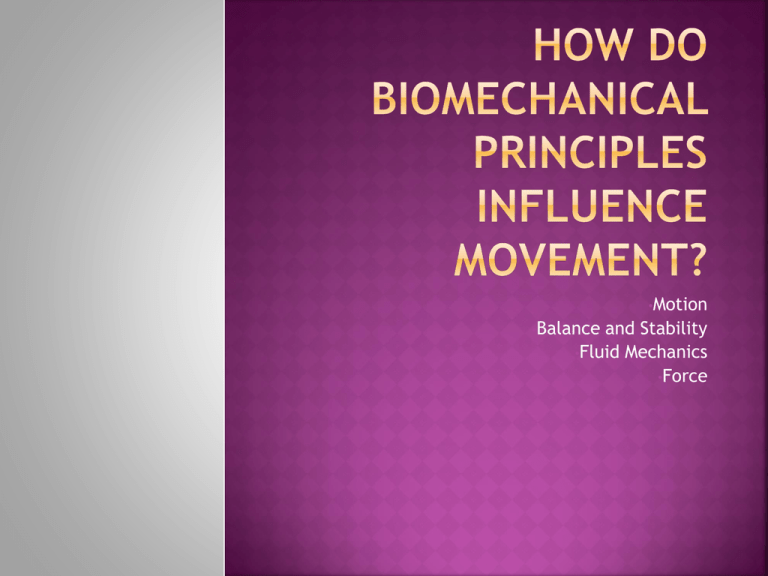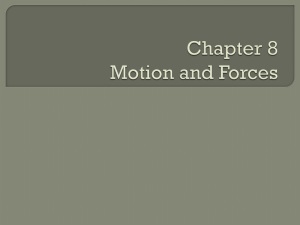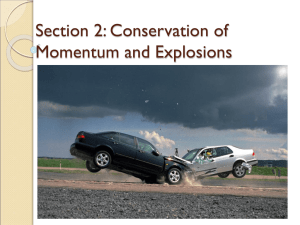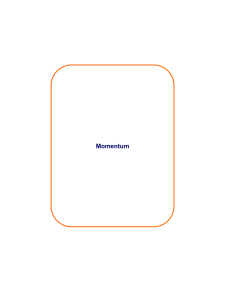How do Biomechanical Principles Influence Movement?
advertisement

•Motion •Balance and Stability •Fluid Mechanics •Force Biomechanics is a science concerned with forces and the effect of these forces on and within the human body. It helps us to understand the use of techniques in different sports and improve the efficiency of movement. It allows us to choose the best technique to achieve our best performance with consideration to our body shape. It aids us in the reduction of injury normally associated with poor technique or movements that are not biomechanically sound. It also influences the design and use of equipment that contributes to improved performance. Complete the cloze passage on page 84 of your booklet using the information below: Motion, or movement is fundamental in sport. Motion occurs as a result of force, the muscular system being the source of force in the human body. There are two types of motion, linear and angular. Linear motion is movement in a straight line, such a ball rolling along the ground. Angular motion is rotation around an axis, such as a gymnast on the bars. Angular motion occurs at joints, for example flexing the elbow is angular motion. The combination of angular and linear motion is known as general motion. A 100 metre sprint is an example of general motion because the angular motion at the joints combines to cause movement in a straight line. Momentum is basically a combination of speed and mass. If two athletes weighed the same, but one was travelling faster than the other, the quicker athlete would have more momentum. Similarly, if two athletes were travelling at the same speed, the heavier athlete would have more momentum. Momentum is of particular importance in sports where impacts occur such as AFL, league and union. The outcome of a collision depends largely on the amount of momentum that each body had prior to the impact. The athlete with more momentum would be more difficult to stop in a tackle. If two athletes collide, the one with the least momentum will suffer a change in momentum or impulse. This can be seen when a small player looks like they have bounced off a larger player, or when a stationary snooker ball is hit by the cue ball. If force is applied to an object off-centre, then torque is produced. For example, pushing on a bike pedal when it is in front of the axis will result in forward motion, or hitting a ball with topspin or sidespin has the same effect. Motion: Is the movement of a body from one position to another. Projectile Motion: Is the movement of an object or body in the air. Angular Momentum: Is the tendency of a body or object to continue to spin or rotate. Linear Motion: Takes place when a body and all parts connected to it travel the same distance in the same direction and at the same speed. E.g. A person standing still on a moving escalator or in a lift and a down hill skier have linear motion. The easiest way to determine if a body is experiencing linear motion is to draw a line connecting two parts of the body e.g. The neck and the hips. If the line remains in the same position when the body moves from one position to another, the motion is linear. In your exercise books, list examples of sports or activities where the athlete is experiencing linear motion. Velocity: Is equal to displacement divided by time. Velocity = displacement time It is used where the object or person does not move in a straight line. E.g. A runner in a cross country race, the flight of a javelin. Displacement is the movement of as body from one location to another in a particular direction, or an ‘as the crow flies’ measurement. Five Kilometres (distance) Speed: Is equal to the distance covered, divided by the time taken to cover the distance. Speed = distance time When an object such as a car moves along a road, or a person runs in a race, we often refer to how fast each is moving. This is called speed. If a runner covers a 100m track in 12 seconds, speed is determined by dividing the 100m distance by the time: 100 12 = 8.3 metres per second (m/s) Acceleration: Is the rate at which velocity changes in a given amount of time. This means that an object or a person has the ability to increase speed quickly. When a person or object is stationary it has zero velocity. An increase in velocity is referred to as positive acceleration, whereas a decrease in velocity is called negative acceleration. E.g. A long jumper would have zero velocity in preparation for a jump. The jumper would experience positive acceleration during the approach and until contact with the pit, when acceleration would be negative. Momentum: Refers to the quantity of motion that a body possesses. It is a product of mass and velocity (mass refers to the amount of matter in a body). Momentum is expressed as: Momentum = mass x velocity (M = mv) The application of the principle of momentum is most significant in impact or collision situations. E.g. a truck travelling at 50km per hour collides with a car going at the same speed it would have a devastating effect on the car because the mass of the truck is much greater than that of the car. The car would be taken in the direction that the truck was going. This same principle can be applied to sports such as rugby league and union, where collisions in the form of tackles are part of the game. However, collision between players exhibits different characteristics due to a range of factors such as: the mass difference of the players, elasticity of the human body and the evasive skills of player. Complete the questions on pages 85-86 of your work booklets. Do not worry about the practical activity on page 86, we will complete this later. Then read through Balance and Stability on page 88 of your work booklet and if you have time, attempt to answer the questions on pages 88-89. For support and extra resources refer to page 223228 of your text books. (Text books located in computer cupboard) HAVE A GREAT WEEKEND EVERYONE!!











